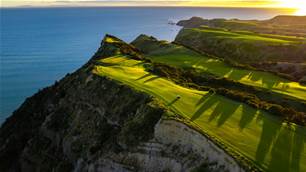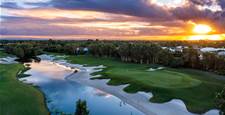Ranfurlie Golf Club sits on the same sandy loam as its more celebrated Sandbelt neighbours, and loses nothing in terms of agronomy, design or conditioning, writes Brett Geeves
Some stories begin in luxury: champagne arrivals, a Fijian choir, a ukulele, valet parking, automated cars driven by an iPhone, the pursed lips of someone who’s about to charge you $27 for a croissant.
This isn’t that story. This one begins in Cranbourne.
East of Frankston, south of Dandenong South, somewhere between suburban sprawl, fresh housing estates and a Mitre 10 which does a surprisingly good sausage sandwich, it’s a part of Melbourne you don’t see on tourism billboards, unless the billboard is for four-bedroom homes and a 45-minute commute.
However, nestled in this landscape of Aussie underdog grit, sitting on traditional and true “Sandbelt land”, is a golf course which might just be the most misunderstood gem in Australia: Ranfurlie.
But first, let’s define “The Sandbelt”. For it’s more than soil. It’s history, strategy, identity; a golden thread woven through the southeast of Melbourne, where golf’s most revered designers, with subtle artistry and enduring genius, shaped courses using the land’s natural flow.
The Sandbelt’s foundation lies in a narrow stretch of ancient, sandy loam, running through the suburbs of Cheltenham, Black Rock, Beaumaris, Sandringham and Clayton South, forming the sandy cradle for icons like Royal Melbourne, Kingston Heath, Victoria, Commonwealth and more.
It’s this famous soil – free-draining, firm underfoot, wonderfully playable year-round – that gives Sandbelt golf its bounce, its precision, its soul. It’s a soil that invites options. It challenges the ground game.
Ranfurlie is just outside the Sandbelt zone, but firmly within the same traditional, sandy soil system; part of the very landmass that makes Melbourne golf world-famous.
It’s not a matter of agronomy, design merit or conditioning. Ranfurlie has all three in spades. So, what is it? It feels like something harder to aerate. While some clubs offer luxury architecture and prestige branding tied to upscale postcodes, Ranfurlie delivers outstanding golf in a welcoming, community-driven setting that feels authentically Australian. And, here in Cranbourne, is a course that plays every bit as strategically, and purely, as anything the region has to offer.
Now, golf has always had an identity problem. And Australian golf courses are in the main a long way from the elitist, gated communities of the United States and Europe. But when the soil is denied an identity because of where it lives, we’re not talking about marketing anymore. We’re talking about a family rift, a denial of blood, a removal from the will.
Ranfurlie’s design is pure golfing intellect; it’s designer Michael Clayton at his strategic, crafty and cunning best. The course blends wide corridors with savage consequences. The fairways are so generous, you’d be forgiven for thinking they are your friend, providing you the green light with free tickets to Birdie Town. But here’s the trick; width doesn’t mean safety, it means options. And if you don’t choose wisely, Ranfurlie will chomp your birdie’s head off and spit out the feathers.
It’s a course that demands you play from the pin backwards. You haven’t earned the right to just bomb driver and hope. Who do you think you are – Rory? You must think. You must scheme. You must look at the far-flung pin and say, “Right, I need to be on the left edge of this eight-lane highway to open up a back-right pin on a green that’s shaped like a melted violin case.”
And if you don’t? You’re short-sided with a 40-metre flop over a bunker which was clearly designed by someone who failed geometry, but majored in pain. Is that a sadist? Or a masochist? I can never remember.
The greens are fast. As in, 11.5 on the Stimpmeter, in the middle of winter, fast. That’s the best kind of lunacy. It is the kind of speed that has you considering whether your putter needs new brake pads. And they are pure. Unbelievably so. The shapes are wild; a combination of subtle contouring, abrupt runoff, and pin positions that feel like riddles. These are truly thrilling greens.
Under the guidance of Course Superintendent Andrew Anderson, with the type of strategic vision you usually find in military operations or high-end kitchen renovations, Ranfurlie is undergoing a five-to-10-year plan to reshape its surfaces, but primarily the rough. The ambition is to carve sharper contrast, to frame the corridors more distinctly, to create visually appealing definition between fairway and rough.
Ranfurlie can feel like your favourite family photo sitting frameless above the fireplace. Leaning diagonally against the wall. The smiles in the centre are perfection, but imagine it in a polished frame?
The future? Straw-coloured fescue: that romantic, wispy, golden backdrop that turns every photo into an oil painting and every bogey into a beautiful one.
“We’re in position to transform our surfaces into something that focuses primarily on playability, but which looks damn good, too,” Anderson says. “The outcome will be a golf course that fulfills Clayton’s design intent. There will be an emphasis on width, angles and playability.”
This change matters. It’s aesthetic, yes, but also strategic. Fescue provides contrast, creating just enough claustrophobia to demand precision, whilst working a Sandbelt palette that screams class without screaming money. And when the trees mature – those currently youthful sticks of hope lining the corridors – you’ll have a visual masterpiece to match the routing.
In five years, Ranfurlie won’t just play like the Sandbelt, it will feel like it. And there’ll be no excuse left for ignoring it. “We want to solidify Ranfurlie’s place as a gem in Australian golf,” Anderson says.
When I visited in July, the course was in immaculate condition. The fairways were tight, lush and spongy enough to tempt a low punch, but firm enough to bounce a running five-iron. The tees were square, level and manicured like a Melbourne barista’s beard.
Being a player with no short game, my favourite holes are always the par-5s, and the 10th hole is the perfect blend of risk and reward, and theatre. From the tee, it looks like a green light special for bombers: wide fairway, downhill run, a green that looks like you can reach it in two. But don’t be fooled. The fairway pinches, the approach is angled, the green complex is a Decepticon; sloping away in all the wrong directions.
The par-4 13th hole is arguably the most “Clayton-esque” on the course. It demands a decision before you even reach the tee. Play safe left, and you’ll face a brutal angle into a shallow, slippery green. Take on the aggressive line right, and you’ll flirt with bunkers
so well-placed, it’s like they know you’re coming. It’s a hole that rewards courage and penalises arrogance. It’s golf design with a degree in psychology.
But it’s the par-4 first hole that, on reflection, had me thinking about where the course is headed. Framed by mature gums on the left and scraggly brush cut of native grass on the right, it looks friendly, even disarming.

For the bombers, the green is in play with the wind behind, and the temptation is real. But the landing zone is tighter than it looks, and anything missed left finds trees, while anything right disappears into deep, thick vegetation.
The smart play is fairway wood or long iron to the left half of the short grass, setting up the best angle into a raised green that’s bunkered tighter than a budget airline seat. Attack it from the right side of the fairway and you’re bringing every hazard into play, plus the emotional scars of a badly chunked half-wedge. It’s the perfect start: gentle in length; bold in strategy; immaculately presented in a polished frame.
If you want a glimpse into the ongoing evolution of Ranfurlie, and how strongly its strategic vision is on future-proofing, it’s evident in the club’s investment in robotics. That’s right: autonomous mowers rule at Ranfurlie, their routes programmed through GPS. It’s not a gimmick. It’s a shift in how course maintenance is evolving.
By reallocating time once spent by people on mundane tasks, the club is focusing on staff development.
“Autonomy is what the golf industry is so desperate for; it’s a circuit breaker,” Anderson says. “Staff are over-worked, inadequately trained and underpaid across the industry. Autonomy is not a means to create redundancy of staff, it’s an opportunity to empower them and their abilities. It’s our commitment to developing the future of the golf industry.”
I was blown away to hear that every tree on the course is registered and is part of a broader health check plan. It’s time reclaimed, skills repurposed, and a quiet leap forward for course management. Plus, there’s something kind of magical about a robot mower gliding silently across the fairway while a magpie swoops it, not knowing its complete lack of impact.
And yet, to be frank, it was hard for me not to leave Ranfurlie angry. Not angry at the course, mind, or the people. No way. It is so rare to walk into a golf club as a total unknown and have four strangers tip their cap and say “G’day” as you walk past the practice green. One bloke even shouted, “Welcome, cobber!” I loved it.
We talk about “growing the game”. About making golf more accessible. More diverse. Well, here it is. On a platter: raw, strategic, brilliantly designed, and socially conscious.
Ranfurlie is a vegetation strategy and natural tree growth from being everything the Sandbelt should be. And the fact it’s not widely recognised as such is a failure not of geography, but of imagination, and equity. Anderson says he and the staff are “thrilled to unlock the full potential of this incredible site”.
“And with our ongoing investment in strategic enhancements, inclusive programs, and sustainable practices, we’re not just building a better course, we’re fostering a vibrant club that welcomes golfers from all walks of life and which holds its own among the region’s finest.”
Related Articles

Review: Clearwater Golf Club

International Spotlight: Omanu Golf Club















